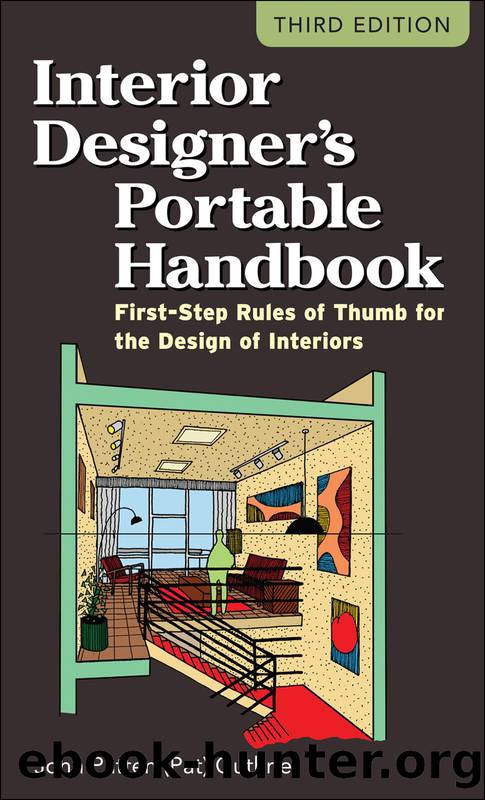Interior Designer's Portable Handbook by (Pat) Patten (Pat) (Pat) Guthrie

Author:(Pat) Patten (Pat) (Pat) Guthrie
Language: eng
Format: epub
ISBN: 0071782079
Publisher: McGraw-Hill Education
Published: 2012-08-15T00:00:00+00:00
__ 2. Lumber
__ a. Sizes
__ (1) Sectional
__ (2) Lengths
__ (a) Softwoods: cut to lengths of 6â² to 24â², in 2â² increments
__ (b) Hardwoods: cut to 1â³-long increments
__ b. Economy: best achieved when layouts are within a 2â²- or 4â²-module, with subdivisions of 4â³, 16â³, 24â³, and 48â³
__ c. Defects: See diagram below and on following page.
__ d. Grades
__ (1) Factory or shop-type lumber: used primarily for remanufacturing purposes (doors, windows, millwork, etc.).
__ (2) Yard-type lumber
__ (a) Boards:
__ 1Ⳡto 1½Ⳡthick, 2Ⳡand wider
__ Graded for appearance only
__ Used as siding, subflooring, trim
__ (b) Dimensioned lumber:
__ 2â³ to 4â³ thick, 2â³ and wider
__ Graded for strength (stress gr.)
__ Used for general construction
__ Light framing: 2â³ to 4â³ wide
__ Joists and planks: 6â³ and wider
__ Decking: 4â³ and wider (select and commercial).
__ (c) Timbers:
__ 5â³ Ã 5â³ and larger
__ Graded for strength and serviceability
__ May be classified as âstructural.â
__ (3) Structural grades (in descending order, according to stress grade):
__ (a) Light framing: Construction, Standard, and Utility
__ (b) Structural light framing (joists, planks): Select Structural, No. 1, 2, or 3 (some species may also be appearance-graded for exposed work).
__ (c) Timber: Select Structural No. 1.
Note: Working stress values can be assigned to each of the grades according to the species of wood.
__ (4) Appearance grades
__ (a) For natural finishes: Select A or B.
__ (b) For paint finishes: Select C or D.
__ (c) For general construction and utility: Common, Nos. 1 thru 5.
__ e. Pressure-treated wood: Softwood lumber treated by a process that forces preservative chemicals into the cells of the wood. The result is a material that is immune to decay. This should not generally be used for interiors. Where required:
__ (1) In direct contact with earth
__ (2) Floor joists less than 18â³ (or girders less than 12â³) from the ground
__ (3) Plates, sills, or sleepers in contact with concrete or masonry
__ (4) Posts exposed to weather or in basements
__ (5) Ends of beams entering concrete or masonry, without ½Ⳡair space
__ (6) Wood located less than 6â³ from earth
__ (7) Wood structural members supporting moisture-permeable floors or roofs, exposed to weather, unless separated by an impervious moisture barrier
__ (8) Wood retaining walls or crib walls
__ (9) For exterior construction such as stairs and railings, in geographic areas where experience has demonstrated the need
__ f. Framing-estimating rules of thumb: For 16-inch oc stud partitions, estimate one stud for every LF of wall, then add for top and bottom plates. For any type of framing, the quantity of basic framing members (in LF) can be determined based on spacing and surface area (SF):
Download
This site does not store any files on its server. We only index and link to content provided by other sites. Please contact the content providers to delete copyright contents if any and email us, we'll remove relevant links or contents immediately.
| Automotive | Engineering |
| Transportation |
Whiskies Galore by Ian Buxton(41710)
Introduction to Aircraft Design (Cambridge Aerospace Series) by John P. Fielding(33011)
Small Unmanned Fixed-wing Aircraft Design by Andrew J. Keane Andras Sobester James P. Scanlan & András Sóbester & James P. Scanlan(32678)
Craft Beer for the Homebrewer by Michael Agnew(18072)
Turbulence by E. J. Noyes(7888)
The Complete Stick Figure Physics Tutorials by Allen Sarah(7257)
Kaplan MCAT General Chemistry Review by Kaplan(6811)
The Thirst by Nesbo Jo(6748)
Bad Blood by John Carreyrou(6467)
Modelling of Convective Heat and Mass Transfer in Rotating Flows by Igor V. Shevchuk(6348)
Learning SQL by Alan Beaulieu(6152)
Weapons of Math Destruction by Cathy O'Neil(6074)
Man-made Catastrophes and Risk Information Concealment by Dmitry Chernov & Didier Sornette(5865)
Digital Minimalism by Cal Newport;(5576)
Life 3.0: Being Human in the Age of Artificial Intelligence by Tegmark Max(5395)
iGen by Jean M. Twenge(5293)
Secrets of Antigravity Propulsion: Tesla, UFOs, and Classified Aerospace Technology by Ph.D. Paul A. Laviolette(5231)
Design of Trajectory Optimization Approach for Space Maneuver Vehicle Skip Entry Problems by Runqi Chai & Al Savvaris & Antonios Tsourdos & Senchun Chai(4949)
Electronic Devices & Circuits by Jacob Millman & Christos C. Halkias(4859)
